Health Variations 2 Assessment 2: Case Study
VerifiedAdded on 2023/06/07
|9
|2305
|391
AI Summary
This case study discusses the components of a valid routine subcutaneous insulin medication order, NovoRapid insulin, hypoglycaemia, medication administration, insulin pen needle length, nursing assessment, potential impact of type 1 diabetes, and daily physical and emotional challenges of living with type 1 diabetes.
Contribute Materials
Your contribution can guide someone’s learning journey. Share your
documents today.
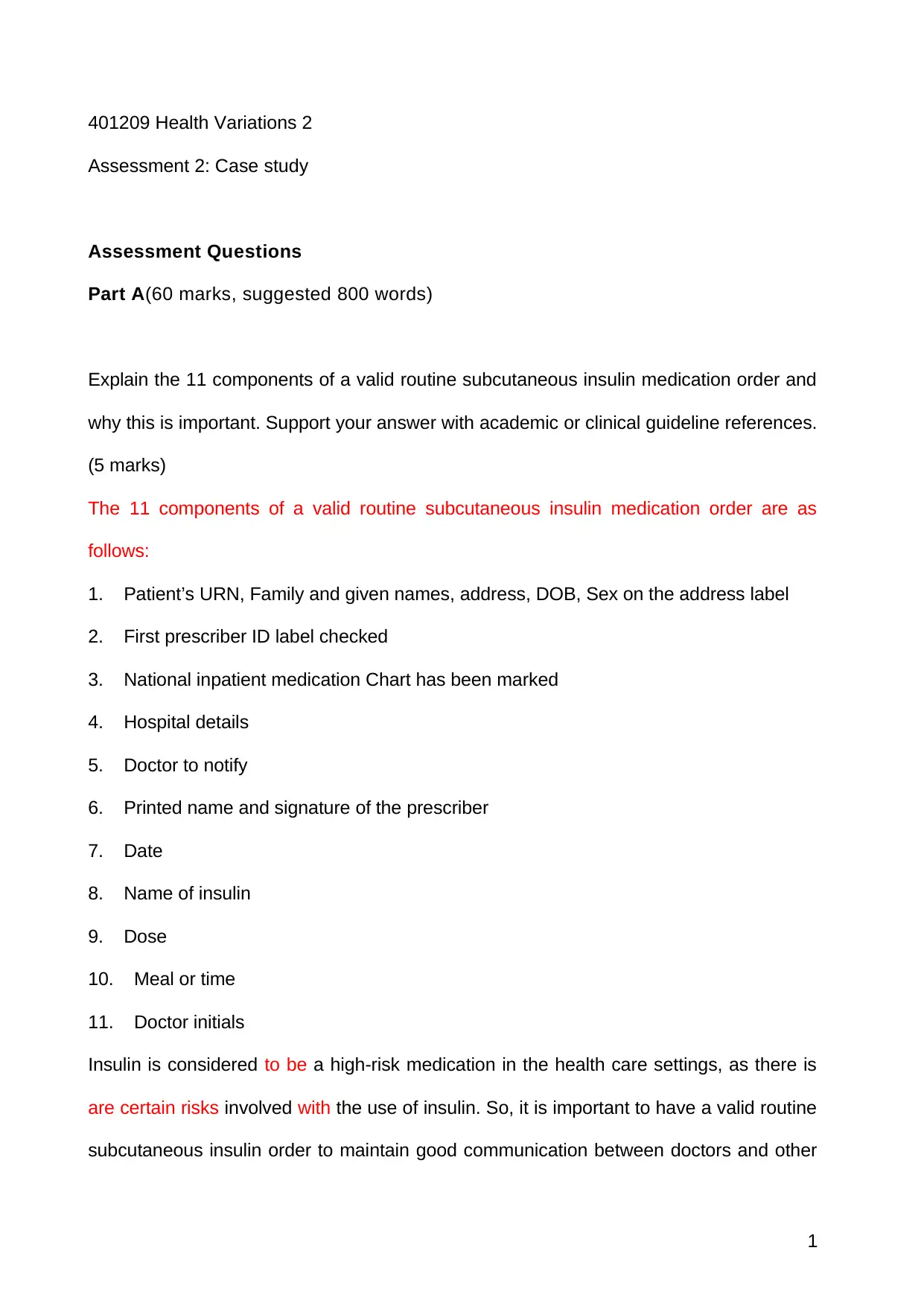
401209 Health Variations 2
Assessment 2: Case study
Assessment Questions
Part A(60 marks, suggested 800 words)
Explain the 11 components of a valid routine subcutaneous insulin medication order and
why this is important. Support your answer with academic or clinical guideline references.
(5 marks)
The 11 components of a valid routine subcutaneous insulin medication order are as
follows:
1. Patient’s URN, Family and given names, address, DOB, Sex on the address label
2. First prescriber ID label checked
3. National inpatient medication Chart has been marked
4. Hospital details
5. Doctor to notify
6. Printed name and signature of the prescriber
7. Date
8. Name of insulin
9. Dose
10. Meal or time
11. Doctor initials
Insulin is considered to be a high-risk medication in the health care settings, as there is
are certain risks involved with the use of insulin. So, it is important to have a valid routine
subcutaneous insulin order to maintain good communication between doctors and other
1
Assessment 2: Case study
Assessment Questions
Part A(60 marks, suggested 800 words)
Explain the 11 components of a valid routine subcutaneous insulin medication order and
why this is important. Support your answer with academic or clinical guideline references.
(5 marks)
The 11 components of a valid routine subcutaneous insulin medication order are as
follows:
1. Patient’s URN, Family and given names, address, DOB, Sex on the address label
2. First prescriber ID label checked
3. National inpatient medication Chart has been marked
4. Hospital details
5. Doctor to notify
6. Printed name and signature of the prescriber
7. Date
8. Name of insulin
9. Dose
10. Meal or time
11. Doctor initials
Insulin is considered to be a high-risk medication in the health care settings, as there is
are certain risks involved with the use of insulin. So, it is important to have a valid routine
subcutaneous insulin order to maintain good communication between doctors and other
1
Secure Best Marks with AI Grader
Need help grading? Try our AI Grader for instant feedback on your assignments.
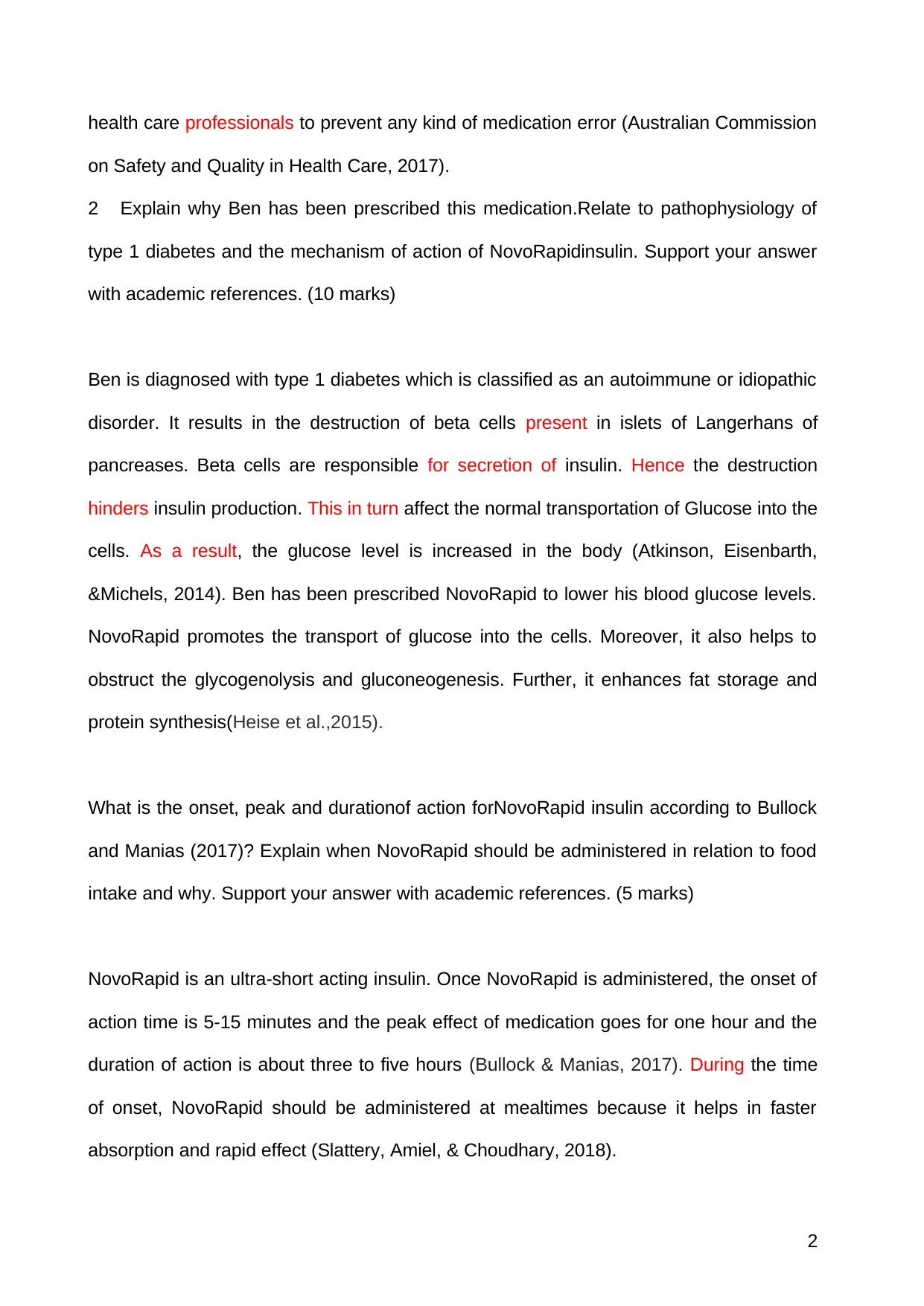
health care professionals to prevent any kind of medication error (Australian Commission
on Safety and Quality in Health Care, 2017).
2 Explain why Ben has been prescribed this medication.Relate to pathophysiology of
type 1 diabetes and the mechanism of action of NovoRapidinsulin. Support your answer
with academic references. (10 marks)
Ben is diagnosed with type 1 diabetes which is classified as an autoimmune or idiopathic
disorder. It results in the destruction of beta cells present in islets of Langerhans of
pancreases. Beta cells are responsible for secretion of insulin. Hence the destruction
hinders insulin production. This in turn affect the normal transportation of Glucose into the
cells. As a result, the glucose level is increased in the body (Atkinson, Eisenbarth,
&Michels, 2014). Ben has been prescribed NovoRapid to lower his blood glucose levels.
NovoRapid promotes the transport of glucose into the cells. Moreover, it also helps to
obstruct the glycogenolysis and gluconeogenesis. Further, it enhances fat storage and
protein synthesis(Heise et al.,2015).
What is the onset, peak and durationof action forNovoRapid insulin according to Bullock
and Manias (2017)? Explain when NovoRapid should be administered in relation to food
intake and why. Support your answer with academic references. (5 marks)
NovoRapid is an ultra-short acting insulin. Once NovoRapid is administered, the onset of
action time is 5-15 minutes and the peak effect of medication goes for one hour and the
duration of action is about three to five hours (Bullock & Manias, 2017). During the time
of onset, NovoRapid should be administered at mealtimes because it helps in faster
absorption and rapid effect (Slattery, Amiel, & Choudhary, 2018).
2
on Safety and Quality in Health Care, 2017).
2 Explain why Ben has been prescribed this medication.Relate to pathophysiology of
type 1 diabetes and the mechanism of action of NovoRapidinsulin. Support your answer
with academic references. (10 marks)
Ben is diagnosed with type 1 diabetes which is classified as an autoimmune or idiopathic
disorder. It results in the destruction of beta cells present in islets of Langerhans of
pancreases. Beta cells are responsible for secretion of insulin. Hence the destruction
hinders insulin production. This in turn affect the normal transportation of Glucose into the
cells. As a result, the glucose level is increased in the body (Atkinson, Eisenbarth,
&Michels, 2014). Ben has been prescribed NovoRapid to lower his blood glucose levels.
NovoRapid promotes the transport of glucose into the cells. Moreover, it also helps to
obstruct the glycogenolysis and gluconeogenesis. Further, it enhances fat storage and
protein synthesis(Heise et al.,2015).
What is the onset, peak and durationof action forNovoRapid insulin according to Bullock
and Manias (2017)? Explain when NovoRapid should be administered in relation to food
intake and why. Support your answer with academic references. (5 marks)
NovoRapid is an ultra-short acting insulin. Once NovoRapid is administered, the onset of
action time is 5-15 minutes and the peak effect of medication goes for one hour and the
duration of action is about three to five hours (Bullock & Manias, 2017). During the time
of onset, NovoRapid should be administered at mealtimes because it helps in faster
absorption and rapid effect (Slattery, Amiel, & Choudhary, 2018).
2
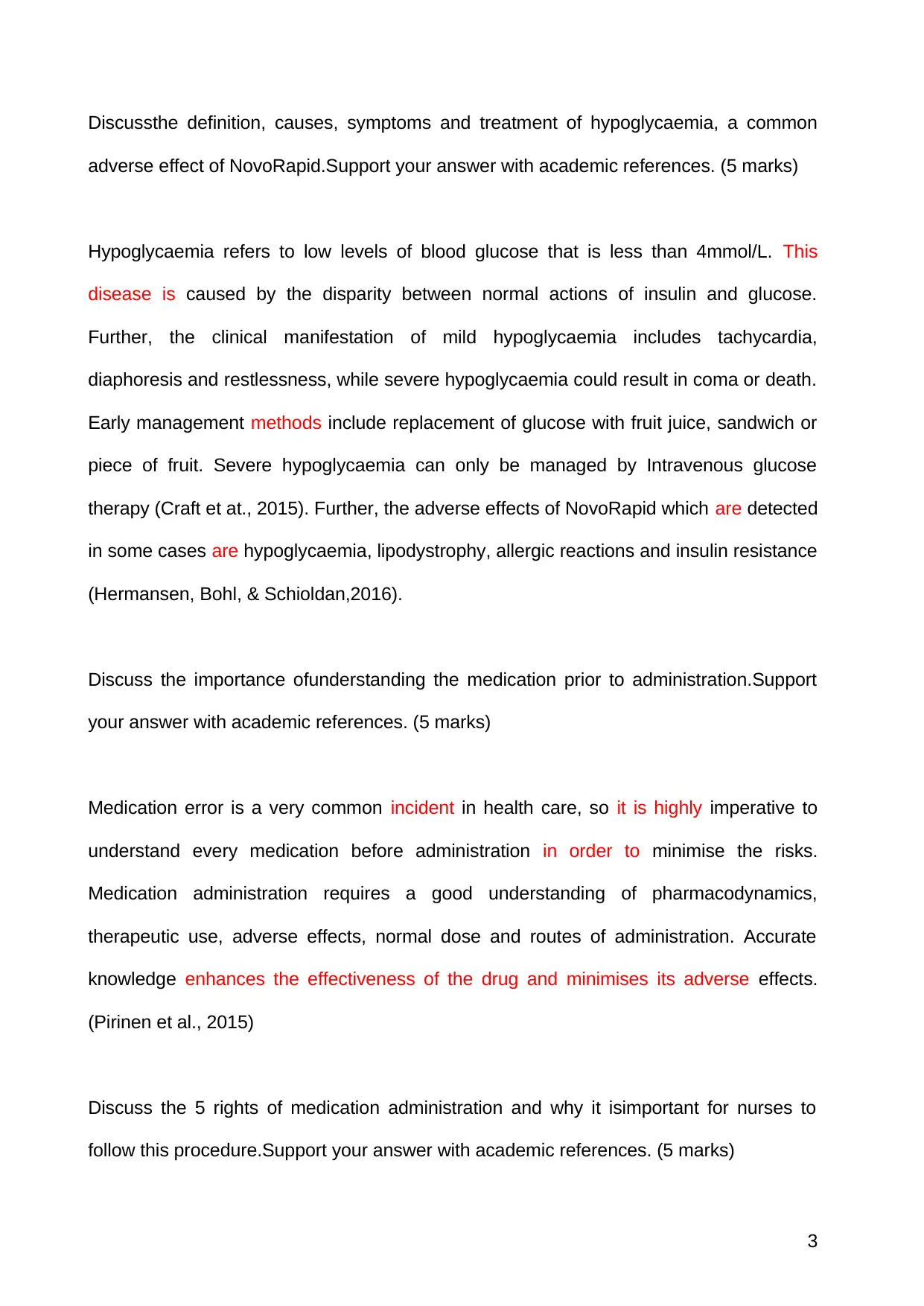
Discussthe definition, causes, symptoms and treatment of hypoglycaemia, a common
adverse effect of NovoRapid.Support your answer with academic references. (5 marks)
Hypoglycaemia refers to low levels of blood glucose that is less than 4mmol/L. This
disease is caused by the disparity between normal actions of insulin and glucose.
Further, the clinical manifestation of mild hypoglycaemia includes tachycardia,
diaphoresis and restlessness, while severe hypoglycaemia could result in coma or death.
Early management methods include replacement of glucose with fruit juice, sandwich or
piece of fruit. Severe hypoglycaemia can only be managed by Intravenous glucose
therapy (Craft et at., 2015). Further, the adverse effects of NovoRapid which are detected
in some cases are hypoglycaemia, lipodystrophy, allergic reactions and insulin resistance
(Hermansen, Bohl, & Schioldan,2016).
Discuss the importance ofunderstanding the medication prior to administration.Support
your answer with academic references. (5 marks)
Medication error is a very common incident in health care, so it is highly imperative to
understand every medication before administration in order to minimise the risks.
Medication administration requires a good understanding of pharmacodynamics,
therapeutic use, adverse effects, normal dose and routes of administration. Accurate
knowledge enhances the effectiveness of the drug and minimises its adverse effects.
(Pirinen et al., 2015)
Discuss the 5 rights of medication administration and why it isimportant for nurses to
follow this procedure.Support your answer with academic references. (5 marks)
3
adverse effect of NovoRapid.Support your answer with academic references. (5 marks)
Hypoglycaemia refers to low levels of blood glucose that is less than 4mmol/L. This
disease is caused by the disparity between normal actions of insulin and glucose.
Further, the clinical manifestation of mild hypoglycaemia includes tachycardia,
diaphoresis and restlessness, while severe hypoglycaemia could result in coma or death.
Early management methods include replacement of glucose with fruit juice, sandwich or
piece of fruit. Severe hypoglycaemia can only be managed by Intravenous glucose
therapy (Craft et at., 2015). Further, the adverse effects of NovoRapid which are detected
in some cases are hypoglycaemia, lipodystrophy, allergic reactions and insulin resistance
(Hermansen, Bohl, & Schioldan,2016).
Discuss the importance ofunderstanding the medication prior to administration.Support
your answer with academic references. (5 marks)
Medication error is a very common incident in health care, so it is highly imperative to
understand every medication before administration in order to minimise the risks.
Medication administration requires a good understanding of pharmacodynamics,
therapeutic use, adverse effects, normal dose and routes of administration. Accurate
knowledge enhances the effectiveness of the drug and minimises its adverse effects.
(Pirinen et al., 2015)
Discuss the 5 rights of medication administration and why it isimportant for nurses to
follow this procedure.Support your answer with academic references. (5 marks)
3

The medication administration rights include Right Patient, Right Drug, Right Dose, Right
Time and Right Route. These are the safety measures which are very important for
nurses to follow. This administration ensures the safety of the patient related to drug
administration and prevents any kind of drug error (NSW Health, 2013). In this case
study, the registered nurse must identify that Ben has been prescribed NovoRapid, the
dose is 10 units, the route is subcutaneous, and the frequency is TDS.
What isthe most appropriateinsulin pen needle lengthfor Ben and why?Support your
answer with academic references. (5 marks)
As per the case study, Ben has been prescribed NovoRapid insulin via Flexpen. The
most appropriate needle size for Ben will be 4mm. As mentioned in the case study Ben
has lost his weight, So the preferred needle for thin patients is 4mm to avoid
intramuscular puncture (Australian Diabetes Educators Association, 2015).
What diabetes specific nursing assessment would you conduct prior to administration of
NovoRapid insulin to Ben and why?Support your answer with academic references. (5
marks)
The most significant nursing assessment is blood glucose monitoring, which nurse will
perform prior to the administration of NovoRapid to Ben. It will help the nurse to provide
accurate information about blood glucose levels and will also help with dose adjustments.
Moreover, it helps to detect hypoglycaemia or hyperglycaemia (Iqbal, Novodvorsky, &
Heller, 2018)
4
Time and Right Route. These are the safety measures which are very important for
nurses to follow. This administration ensures the safety of the patient related to drug
administration and prevents any kind of drug error (NSW Health, 2013). In this case
study, the registered nurse must identify that Ben has been prescribed NovoRapid, the
dose is 10 units, the route is subcutaneous, and the frequency is TDS.
What isthe most appropriateinsulin pen needle lengthfor Ben and why?Support your
answer with academic references. (5 marks)
As per the case study, Ben has been prescribed NovoRapid insulin via Flexpen. The
most appropriate needle size for Ben will be 4mm. As mentioned in the case study Ben
has lost his weight, So the preferred needle for thin patients is 4mm to avoid
intramuscular puncture (Australian Diabetes Educators Association, 2015).
What diabetes specific nursing assessment would you conduct prior to administration of
NovoRapid insulin to Ben and why?Support your answer with academic references. (5
marks)
The most significant nursing assessment is blood glucose monitoring, which nurse will
perform prior to the administration of NovoRapid to Ben. It will help the nurse to provide
accurate information about blood glucose levels and will also help with dose adjustments.
Moreover, it helps to detect hypoglycaemia or hyperglycaemia (Iqbal, Novodvorsky, &
Heller, 2018)
4
Secure Best Marks with AI Grader
Need help grading? Try our AI Grader for instant feedback on your assignments.
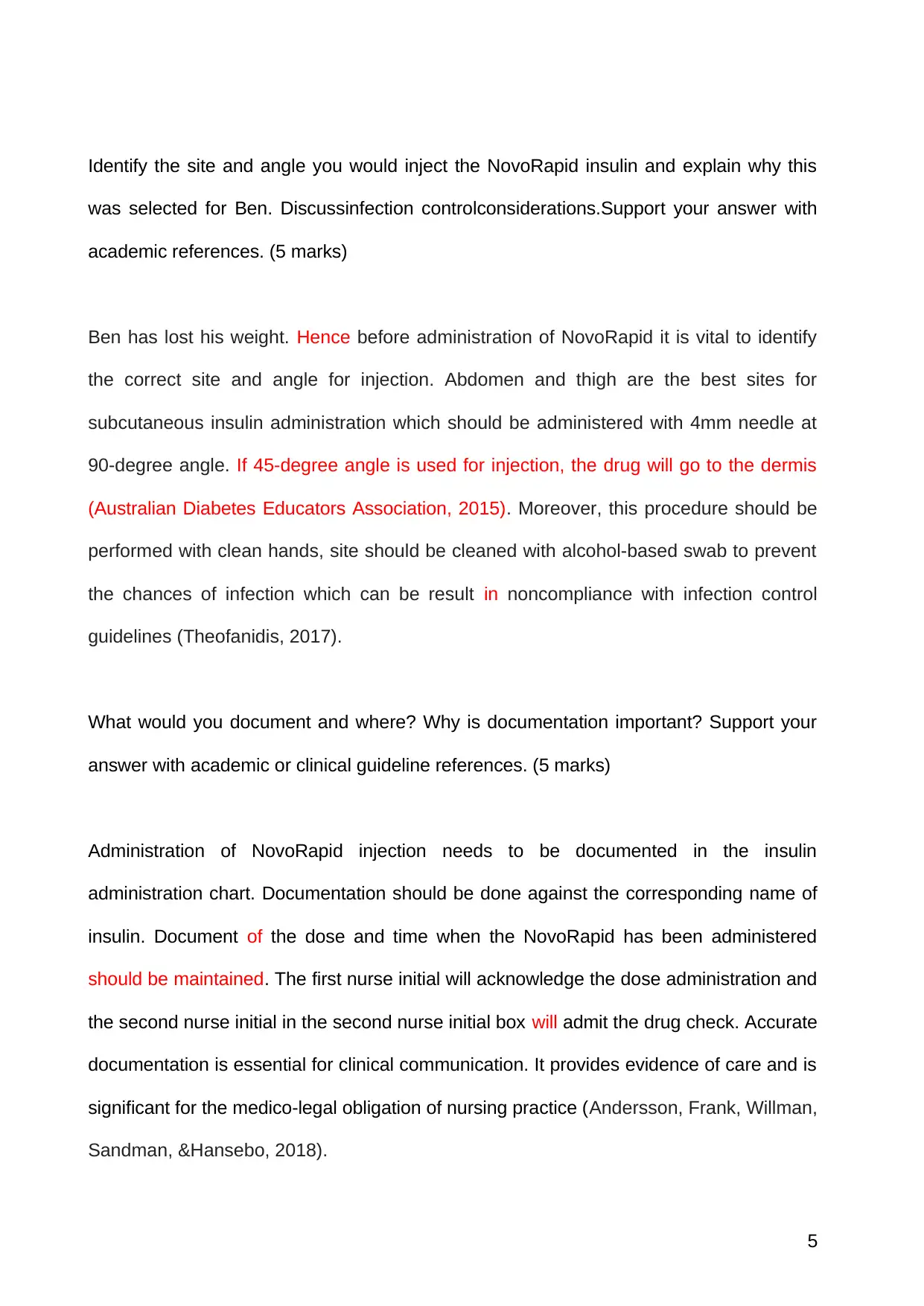
Identify the site and angle you would inject the NovoRapid insulin and explain why this
was selected for Ben. Discussinfection controlconsiderations.Support your answer with
academic references. (5 marks)
Ben has lost his weight. Hence before administration of NovoRapid it is vital to identify
the correct site and angle for injection. Abdomen and thigh are the best sites for
subcutaneous insulin administration which should be administered with 4mm needle at
90-degree angle. If 45-degree angle is used for injection, the drug will go to the dermis
(Australian Diabetes Educators Association, 2015). Moreover, this procedure should be
performed with clean hands, site should be cleaned with alcohol-based swab to prevent
the chances of infection which can be result in noncompliance with infection control
guidelines (Theofanidis, 2017).
What would you document and where? Why is documentation important? Support your
answer with academic or clinical guideline references. (5 marks)
Administration of NovoRapid injection needs to be documented in the insulin
administration chart. Documentation should be done against the corresponding name of
insulin. Document of the dose and time when the NovoRapid has been administered
should be maintained. The first nurse initial will acknowledge the dose administration and
the second nurse initial in the second nurse initial box will admit the drug check. Accurate
documentation is essential for clinical communication. It provides evidence of care and is
significant for the medico-legal obligation of nursing practice (Andersson, Frank, Willman,
Sandman, &Hansebo, 2018).
5
was selected for Ben. Discussinfection controlconsiderations.Support your answer with
academic references. (5 marks)
Ben has lost his weight. Hence before administration of NovoRapid it is vital to identify
the correct site and angle for injection. Abdomen and thigh are the best sites for
subcutaneous insulin administration which should be administered with 4mm needle at
90-degree angle. If 45-degree angle is used for injection, the drug will go to the dermis
(Australian Diabetes Educators Association, 2015). Moreover, this procedure should be
performed with clean hands, site should be cleaned with alcohol-based swab to prevent
the chances of infection which can be result in noncompliance with infection control
guidelines (Theofanidis, 2017).
What would you document and where? Why is documentation important? Support your
answer with academic or clinical guideline references. (5 marks)
Administration of NovoRapid injection needs to be documented in the insulin
administration chart. Documentation should be done against the corresponding name of
insulin. Document of the dose and time when the NovoRapid has been administered
should be maintained. The first nurse initial will acknowledge the dose administration and
the second nurse initial in the second nurse initial box will admit the drug check. Accurate
documentation is essential for clinical communication. It provides evidence of care and is
significant for the medico-legal obligation of nursing practice (Andersson, Frank, Willman,
Sandman, &Hansebo, 2018).
5

Explain the diabetes specific nursing assessment you would provide for Ben post
administration of insulin, when you would provide it and why.Support your answer with
academic references. (5 marks)
After administration of insulin to Ben, nurse needs to check blood glucose level after 1
hour of insulin administration to ensure the effect of the medication and to check any
kind of fluctuations in glucose level. This assessment will help nurse in early assessment
of signs of hypoglycaemia, so that the nursing staff can do early interventions to protect
Ben from any adverse complications (Iqbal, Novodvorsky, & Heller, 2018).
Part B (10 marks, suggested 200 words)
Discuss the potential impact of type 1 diabetes on Ben.
Discuss the daily physical challenges of living with type 1 diabetes that Ben may
face.Support your answer with academic references. (5 marks)
Type 1 Diabetes is considered as a chronic illness during childhood. There are certain
physical challenges that could be faced by young children that include changes in life
style like education, living situations, and restrictions on certain physical activities
(Monaghan, Helgeson, & Wiebe, 2015). In this case study it has been mentioned that
Ben is a university student who love to play football and is working In McDonalds on
causal basis. His diagnosis could alter his ability to cope with the game, study and job
responsibilities as he may feel lethargic and weak.
6
administration of insulin, when you would provide it and why.Support your answer with
academic references. (5 marks)
After administration of insulin to Ben, nurse needs to check blood glucose level after 1
hour of insulin administration to ensure the effect of the medication and to check any
kind of fluctuations in glucose level. This assessment will help nurse in early assessment
of signs of hypoglycaemia, so that the nursing staff can do early interventions to protect
Ben from any adverse complications (Iqbal, Novodvorsky, & Heller, 2018).
Part B (10 marks, suggested 200 words)
Discuss the potential impact of type 1 diabetes on Ben.
Discuss the daily physical challenges of living with type 1 diabetes that Ben may
face.Support your answer with academic references. (5 marks)
Type 1 Diabetes is considered as a chronic illness during childhood. There are certain
physical challenges that could be faced by young children that include changes in life
style like education, living situations, and restrictions on certain physical activities
(Monaghan, Helgeson, & Wiebe, 2015). In this case study it has been mentioned that
Ben is a university student who love to play football and is working In McDonalds on
causal basis. His diagnosis could alter his ability to cope with the game, study and job
responsibilities as he may feel lethargic and weak.
6
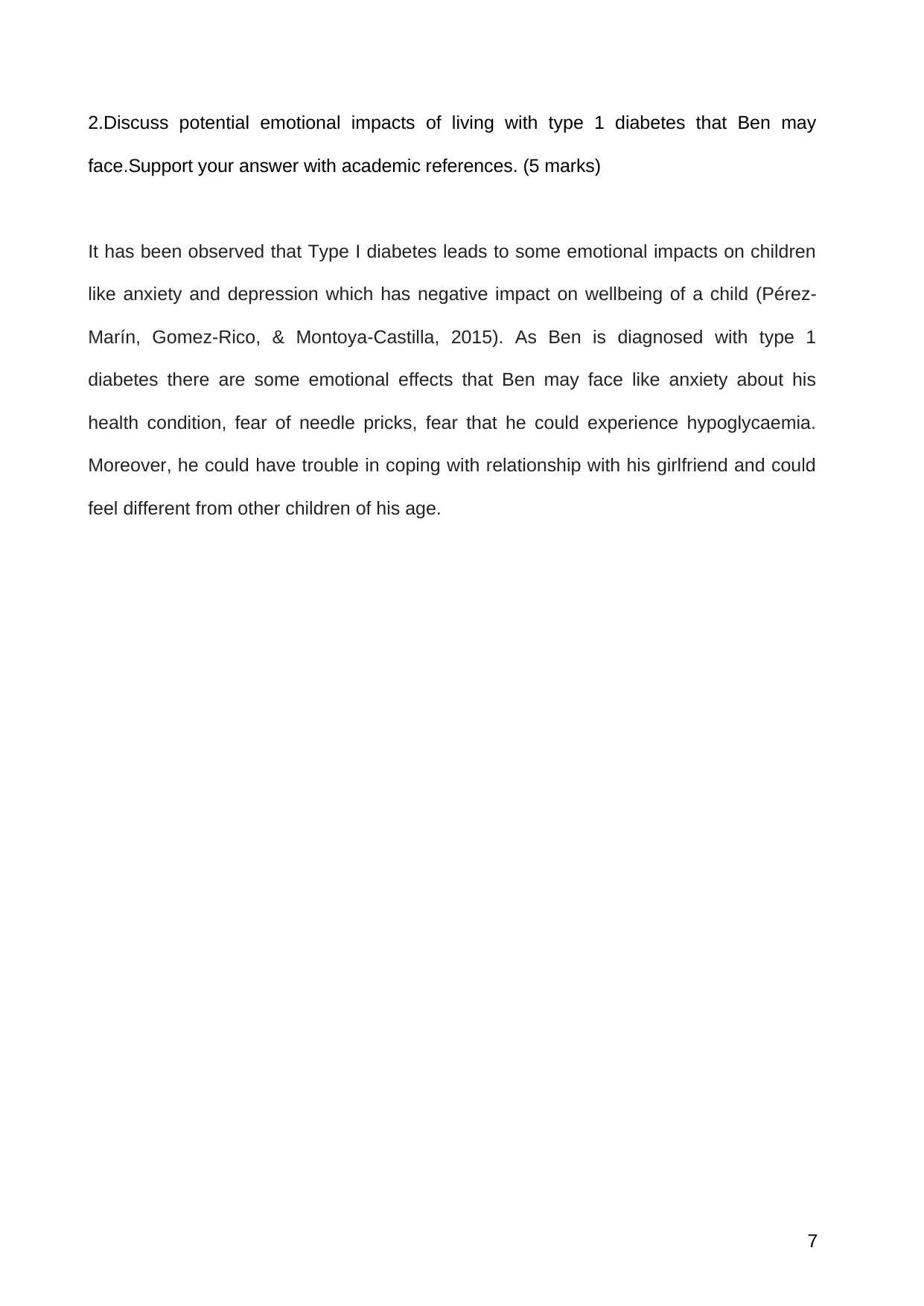
2.Discuss potential emotional impacts of living with type 1 diabetes that Ben may
face.Support your answer with academic references. (5 marks)
It has been observed that Type I diabetes leads to some emotional impacts on children
like anxiety and depression which has negative impact on wellbeing of a child (Pérez-
Marín, Gomez-Rico, & Montoya-Castilla, 2015). As Ben is diagnosed with type 1
diabetes there are some emotional effects that Ben may face like anxiety about his
health condition, fear of needle pricks, fear that he could experience hypoglycaemia.
Moreover, he could have trouble in coping with relationship with his girlfriend and could
feel different from other children of his age.
7
face.Support your answer with academic references. (5 marks)
It has been observed that Type I diabetes leads to some emotional impacts on children
like anxiety and depression which has negative impact on wellbeing of a child (Pérez-
Marín, Gomez-Rico, & Montoya-Castilla, 2015). As Ben is diagnosed with type 1
diabetes there are some emotional effects that Ben may face like anxiety about his
health condition, fear of needle pricks, fear that he could experience hypoglycaemia.
Moreover, he could have trouble in coping with relationship with his girlfriend and could
feel different from other children of his age.
7
Paraphrase This Document
Need a fresh take? Get an instant paraphrase of this document with our AI Paraphraser
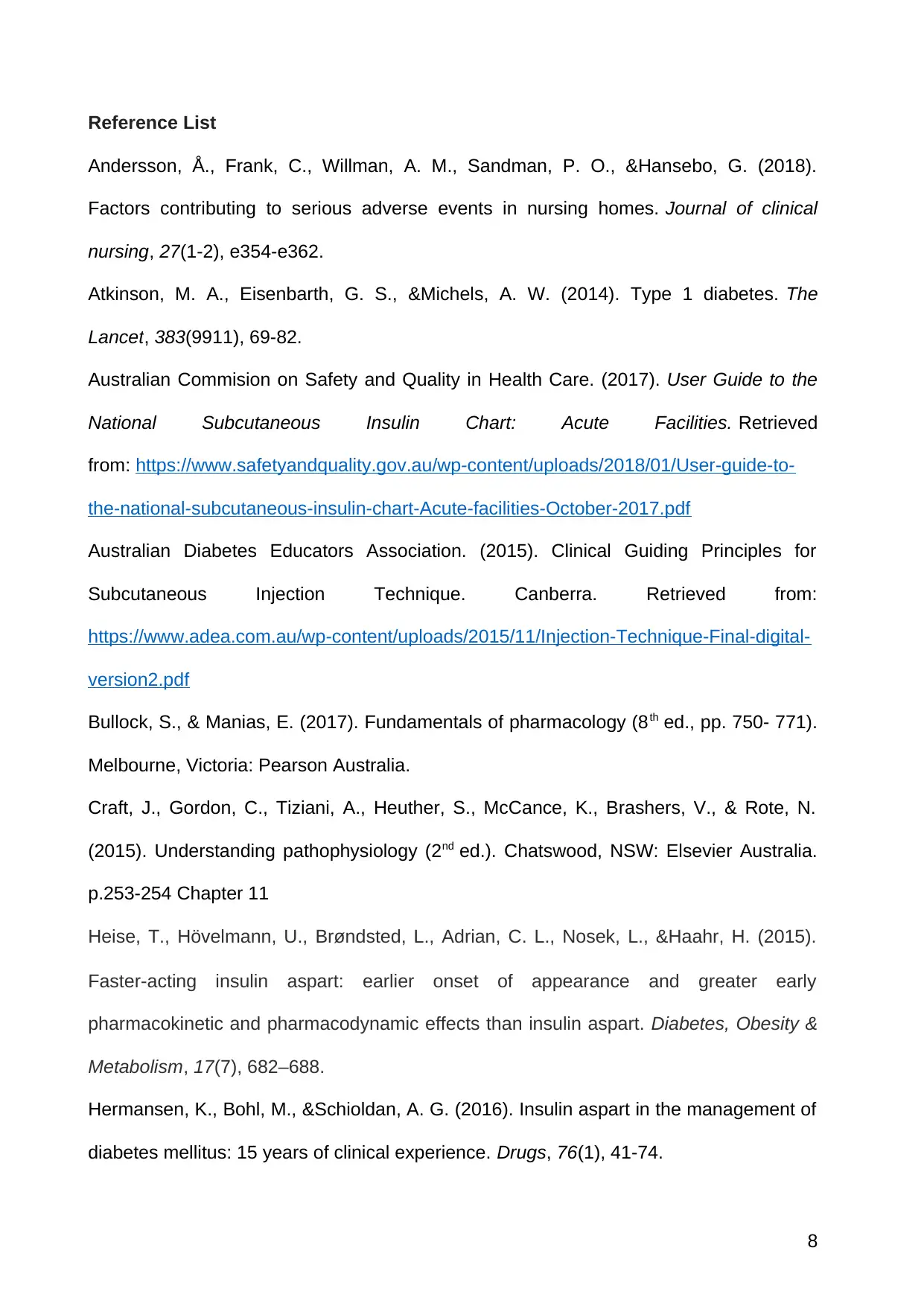
Reference List
Andersson, Å., Frank, C., Willman, A. M., Sandman, P. O., &Hansebo, G. (2018).
Factors contributing to serious adverse events in nursing homes. Journal of clinical
nursing, 27(1-2), e354-e362.
Atkinson, M. A., Eisenbarth, G. S., &Michels, A. W. (2014). Type 1 diabetes. The
Lancet, 383(9911), 69-82.
Australian Commision on Safety and Quality in Health Care. (2017). User Guide to the
National Subcutaneous Insulin Chart: Acute Facilities. Retrieved
from: https://www.safetyandquality.gov.au/wp-content/uploads/2018/01/User-guide-to-
the-national-subcutaneous-insulin-chart-Acute-facilities-October-2017.pdf
Australian Diabetes Educators Association. (2015). Clinical Guiding Principles for
Subcutaneous Injection Technique. Canberra. Retrieved from:
https://www.adea.com.au/wp-content/uploads/2015/11/Injection-Technique-Final-digital-
version2.pdf
Bullock, S., & Manias, E. (2017). Fundamentals of pharmacology (8th ed., pp. 750- 771).
Melbourne, Victoria: Pearson Australia.
Craft, J., Gordon, C., Tiziani, A., Heuther, S., McCance, K., Brashers, V., & Rote, N.
(2015). Understanding pathophysiology (2nd ed.). Chatswood, NSW: Elsevier Australia.
p.253-254 Chapter 11
Heise, T., Hövelmann, U., Brøndsted, L., Adrian, C. L., Nosek, L., &Haahr, H. (2015).
Faster‐acting insulin aspart: earlier onset of appearance and greater early
pharmacokinetic and pharmacodynamic effects than insulin aspart. Diabetes, Obesity &
Metabolism, 17(7), 682–688.
Hermansen, K., Bohl, M., &Schioldan, A. G. (2016). Insulin aspart in the management of
diabetes mellitus: 15 years of clinical experience. Drugs, 76(1), 41-74.
8
Andersson, Å., Frank, C., Willman, A. M., Sandman, P. O., &Hansebo, G. (2018).
Factors contributing to serious adverse events in nursing homes. Journal of clinical
nursing, 27(1-2), e354-e362.
Atkinson, M. A., Eisenbarth, G. S., &Michels, A. W. (2014). Type 1 diabetes. The
Lancet, 383(9911), 69-82.
Australian Commision on Safety and Quality in Health Care. (2017). User Guide to the
National Subcutaneous Insulin Chart: Acute Facilities. Retrieved
from: https://www.safetyandquality.gov.au/wp-content/uploads/2018/01/User-guide-to-
the-national-subcutaneous-insulin-chart-Acute-facilities-October-2017.pdf
Australian Diabetes Educators Association. (2015). Clinical Guiding Principles for
Subcutaneous Injection Technique. Canberra. Retrieved from:
https://www.adea.com.au/wp-content/uploads/2015/11/Injection-Technique-Final-digital-
version2.pdf
Bullock, S., & Manias, E. (2017). Fundamentals of pharmacology (8th ed., pp. 750- 771).
Melbourne, Victoria: Pearson Australia.
Craft, J., Gordon, C., Tiziani, A., Heuther, S., McCance, K., Brashers, V., & Rote, N.
(2015). Understanding pathophysiology (2nd ed.). Chatswood, NSW: Elsevier Australia.
p.253-254 Chapter 11
Heise, T., Hövelmann, U., Brøndsted, L., Adrian, C. L., Nosek, L., &Haahr, H. (2015).
Faster‐acting insulin aspart: earlier onset of appearance and greater early
pharmacokinetic and pharmacodynamic effects than insulin aspart. Diabetes, Obesity &
Metabolism, 17(7), 682–688.
Hermansen, K., Bohl, M., &Schioldan, A. G. (2016). Insulin aspart in the management of
diabetes mellitus: 15 years of clinical experience. Drugs, 76(1), 41-74.
8

Iqbal, A., Novodvorsky, P., & Heller, S. R. (2018). Recent Updates on Type 1 Diabetes
Mellitus Management for Clinicians. Diabetes & metabolism journal, 42(1), 3-18.
Monaghan, M., Helgeson, V., & Wiebe, D. (2015). Type 1 diabetes in young
adulthood. Current diabetes reviews, 11(4), 239-250.
NSW Health. (2013). Medication Handling in NSW Public Health Facilities. Retrieved
from https://www1.health.nsw.gov.au/pds/ActivePDSDocuments/PD2013_043.pdf
Pérez-Marín, M., Gomez-Rico, I., & Montoya-Castilla, I. (2015). Type 1 diabetes
mellitus: psychosocial factors and adjustment of pediatric patient and his/her family.
Review. Archivosargentinos de pediatría, 113(2), 158-162.
Pirinen, H., Kauhanen, L., Danielsson-Ojala, R., Lilius, J., Tuominen, I., Díaz Rodríguez,
N., &Salanterä, S. (2015). Registered Nurses’ experiences with the medication
administration process. Advances in Nursing, 2015.
Reference list
Slattery, D., Amiel, S. A., & Choudhary, P. (2018). Optimal prandial timing of bolus
insulin in diabetes management: a review. Diabetic Medicine, 35(3), 306-316.
Theofanidis, D. (2017). In-Hospital Administration of Insulin by Nurses in
Northern Greece: An Observational Study. Diabetes Spectrum : A
Publication of the American Diabetes Association, 30(3), 175-181.
9
Mellitus Management for Clinicians. Diabetes & metabolism journal, 42(1), 3-18.
Monaghan, M., Helgeson, V., & Wiebe, D. (2015). Type 1 diabetes in young
adulthood. Current diabetes reviews, 11(4), 239-250.
NSW Health. (2013). Medication Handling in NSW Public Health Facilities. Retrieved
from https://www1.health.nsw.gov.au/pds/ActivePDSDocuments/PD2013_043.pdf
Pérez-Marín, M., Gomez-Rico, I., & Montoya-Castilla, I. (2015). Type 1 diabetes
mellitus: psychosocial factors and adjustment of pediatric patient and his/her family.
Review. Archivosargentinos de pediatría, 113(2), 158-162.
Pirinen, H., Kauhanen, L., Danielsson-Ojala, R., Lilius, J., Tuominen, I., Díaz Rodríguez,
N., &Salanterä, S. (2015). Registered Nurses’ experiences with the medication
administration process. Advances in Nursing, 2015.
Reference list
Slattery, D., Amiel, S. A., & Choudhary, P. (2018). Optimal prandial timing of bolus
insulin in diabetes management: a review. Diabetic Medicine, 35(3), 306-316.
Theofanidis, D. (2017). In-Hospital Administration of Insulin by Nurses in
Northern Greece: An Observational Study. Diabetes Spectrum : A
Publication of the American Diabetes Association, 30(3), 175-181.
9
1 out of 9
Related Documents
Your All-in-One AI-Powered Toolkit for Academic Success.
+13062052269
info@desklib.com
Available 24*7 on WhatsApp / Email
![[object Object]](/_next/static/media/star-bottom.7253800d.svg)
Unlock your academic potential
© 2024 | Zucol Services PVT LTD | All rights reserved.




